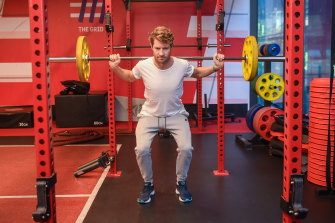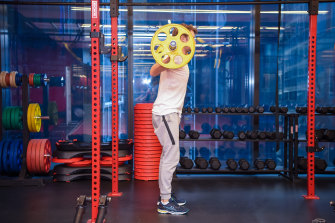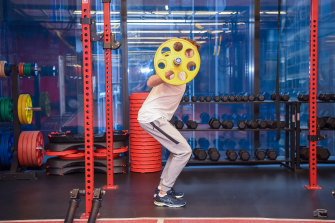The knee movement is key: Your complete guide to the squat
When it comes to exercising at the gym, getting your technique right is crucial. In this series, physiotherapist Luke Pickett takes us step-by-step through the big three movements: the squat, the deadlift and the bench press.
The most valuable exercise for human beings may just be the squat. Every time you sit, you squat. Stairs, single leg squat. Grocery bags to floor, double leg squat. And if you want to tone your core, buttocks and thighs? You got it – squat!
There are countless variations of the squat, including the sissy squat, frog squat, Bulgarian split squat, side kick squat and the ominously named landmine squat. Amusingly, this is only the tip of the iceberg. But just because these are variations of an important exercise, doesn’t mean they are necessarily good for you.
Physiotherapist Luke Pickett performing a squat.Credit:Justin McManus
Let’s delve into the key components of the double leg squat, to ensure that you understand its function, perform the technique correctly and prevent injury.
An overview
The squat is a compound movement. The advantage of this is that you work more muscles in one exercise, making your workout efficient. The disadvantage is that there are more joints to control, making it harder to perform the movement correctly and putting you at greater risk of injury.
The double leg squat predominantly targets the quadriceps (front of thigh) and gluteals (buttocks). It also targets the calves, hamstrings, abdominals and back muscles, all of which can become more of focus with different variations of the squat.
The squat is a leg and core strengthening exercise. And because it activates large muscles, it also creates significant aerobic demand, so can be part of a cardiovascular workout.
For people who play sports or participate in activities like running, cycling or rowing, squats either replicate the movement patterns required or target the specific muscles used in these sports.
As we grow older, we lose muscle conditioning. Some of it is due to less activity and some is due to a decreased ability to generate muscle tissue efficiently. Squatting will help make daily living easier, decrease the risk of falls and support bone health.
Technique
In essence, a squat could not be easier to perform. Stand with your feet shoulder width apart, bend your knees and then straighten them again. Easy! As always, the devil is in the detail.
Start with your feet shoulder width apart and pointing in the direction that is natural for you. Don’t be worried about one foot being slightly more rotated in one direction than the other – we all have asymmetries.
The knee movement is key. Bend your knees to between 45 and 90 degrees of knee range depending on your ability, make sure that they follow the direction that your foot is pointing. Professionally, I prompt patients to, “Keep your knees over your middle toes.” This will help you fire up the correct thigh and buttock muscles.
Fold at your hips, once again to 45-90 degrees depending on your ability, simultaneously with the knee bend so your body is slightly bent forwards. This hip bending will strengthen the buttocks more.
Keep the lumbar spine in a neutral position. Think of this as being a flat lower back, where the spine is not curved either way – not arched backwards into extension and not bent forwards into flexion. Dissociation is a concept of moving a portion of the body without unnecessarily moving the next body part: for a squat, you don’t move at the hips and then drag the lumbar spine into the movement too.
Keep your lower back flat, Luke Pickett says.Credit:Justin McManus
Feel the burn in your quadriceps and glutes, then potentially the calves and hamstrings. Professionally, I start to get concerned when a lifter is feeling the work in the low back and hamstrings predominantly as this indicates the glutes are not activating well. Also, you never want to feel the work in the hip or knee joints. (This goes for all exercise, you want to feel the burn of exercise in muscles not joints, tendons or bones.)
My biggest bugbear with squats is when people are taught to clasp their hands out in front as they squat. It’s common in the gym, but it takes away from a significant benefit of the exercise. By clasping the hands, squatters use an alternative back muscle (the latissimus dorsi, which is the big V-shaped muscle that extends from the lower to upper back – you see this distinctly on swimmers at the Olympics) to stabilise the spine, which then decreases the loading on the back and abdominal muscles that should be performing this stabilisation role. Keep your hands at your sides instead.
If you have decreased ankle range of movement that restricts your squat’s depth, simply put a wedge (1-5 centimetres depending on your need) under your heels to allow a greater depth with the squat. Just beware that this will also load the quadriceps more and the patellofemoral joint (knee cap).
Start with three sets of six repetitions to ensure that you maintain a good technique as you learn the skill of squatting. Then feel free to increase to 8-10 reps as you become confident. When the last repetitions of the third set becomes easy, progress to a higher weight. Keep to the golden rule: No more than a 10 per cent increase in weight. And feel free to decrease the repetitions back to six as you get accustomed to the new load.
If you want to add weight, carrying dumbbells in each hand at your side is the safest way to start. When working with patients, a lightly framed person will start with 1-3 kilograms in each hand and a larger framed person with 5-7.5 kilograms each hand.
Transitioning to using squat racks or cages is a goal of many. Remember, free weight barbell squatting was an exercise only performed by elite athletes and powerlifters, meaning they are for experienced squatters. People who suffer from lower back pain should be cautious. The simplest transition is made by adding some Smith machine work into your squatting routine. The Smith machine has a barbell that is fixed inside two guiding rails, which move vertically up and down in a straight line. Squatting in this supported environment will allow you to become comfortable with using a barbell for squatting and establish your preference for its position on your back or front. Traditionally, I will recommend the bar being placed on the upper back, however for people who have shoulder or neck issues, I recommend the front barbell position.
As you squat, your knees should bend in the direction that your foot is pointing.Credit:Justin McManus
Feel free to try variations of squats. There’s the goblet squat, where you hold a weight at chest height and squat down using the technique we described earlier. Having the weight in the front of your body loads your glutes and back more so please try this once you have good control of the original squat. There’s also the Bosu squat, standing on the flat side of a Bosu ball so you challenge your balance while squatting. With all variations, try to maintain that bent knee over the middle toe position and then you will go a long way to preventing soreness or injury.
Please avoid wall squats and especially sustained wall squats. The forces on the back of the kneecap are highest at 90 degrees of knee bend. Adding the force of pushing back into the wall and sustaining that position is nothing short of a recipe for injury to the patellofemoral joint (kneecap joint).
Avoid using kettlebell swings as part of the squat as this is on par with deadlifts for the greatest injury-causing exercise in the gym. It is almost impossible to control the lumbar spine position with the momentum generated by a kettlebell swing.
Luke Pickett is a physiotherapist who has worked as a head physio for AFL, AIS and Australian sporting teams. He is director of Melbourne Physio Clinic.
Make the most of your health, relationships, fitness and nutrition with our Live Well newsletter. Get it in your inbox every Monday.
Most Viewed in Lifestyle
From our partners
Source: Read Full Article



